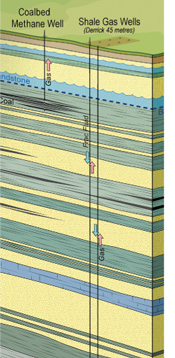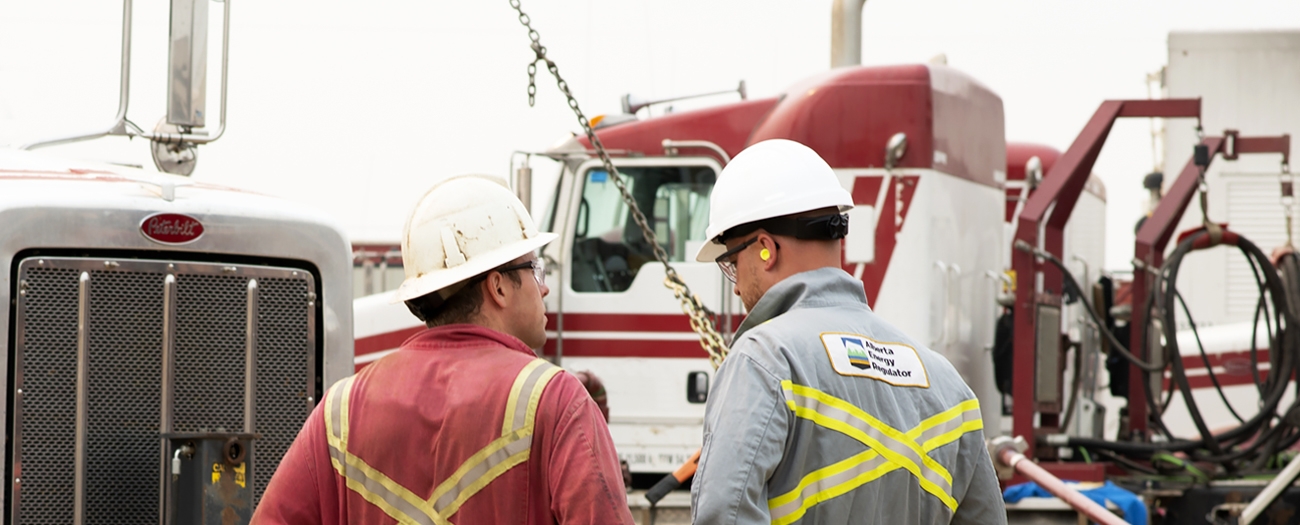Hydraulic fracturing (“fracking”) is a technique used to break up the rocks deep inside the earth to help get the oil and natural gas flowing. It has been used in more than 180 000 wells in Alberta since the 1950s. In fact, most of the natural gas in Alberta is extracted using hydraulic fracturing. Companies must submit applications to us and receive our approval before producing this way.
How does hydraulic fracturing work?
Not all oil and natural gas will flow naturally through rock and be pumped to the surface easily. In this case, oil and natural gas is trapped in low-permeability rock. A pathway must be created to get the resources moving through the rock and to the well. Hydraulic fracturing creates that path.
Companies must pump fluid into a wellbore to create enough pressure to crack, or fracture, the rock layer. The fluid usually contains a “proppant,” like sand, which helps keep the fractures open. This allows oil and gas to move to the well, where it can be pumped to the surface.
How the Well Is Drilled
Companies use both horizontal wells and multistage fracturing to produce the unconventional oil and natural gas. These wells start by drilling vertically (straight down). Companies can then turn the drill bit so that it drills horizontally—making the well resemble the letter “L.”
While horizontal well drilling has been used for decades, improvements in technology have made it possible to combine horizontal drilling with hydraulic fracturing to help coax oil and natural gas out of rock.


Protecting Albertans and the Environment
Some Albertans are concerned about the chemicals that might be used in hydraulic fracturing fluids and the possibility of it entering groundwater. To ensure that our environment is protected, no fluids—including those that have been treated—are ever allowed to be released into a natural water body.
We also require that
- hydraulic fracturing fluids used above the base of groundwater protection be nontoxic;
- the company reveal the contents of the fluids to us upon our request;
- the company keep a daily record of the type and volume of all additives used in fracturing fluids;
- the company use steel casing and cements the wellbore to ensure that the fluid is separated from groundwater and surface water; and
- any produced fluids that are brought to surface, such as hydraulic fracturing fluid or salt water, must be handled, stored, and disposed of under our strict regulations and requirements.
Our requirements prevent any hydraulic fracturing fluid from entering natural water bodies, regardless of whether or not it contains toxic chemicals.
Managing Seismic Activity
Studies have shown us that hydraulic fracturing can cause earthquakes in Alberta. Find out what we’re doing to help manage seismic activity and protect Albertans in areas such as Fox Creek.
Our Detailed Requirements
- Directive 008 Surface Casing Depth Requirements
- Directive 009 Casing Cementing Minimum Requirements
- Directive 047 Waste Reporting Requirements for Oilfield Waste Management Facilities
- Directive 050 Drilling Waste Management
- Directive 055 Storage Requirements for the Upstream Petroleum Industry
- Directive 058 Oilfield Waste Management Requirements for the Upstream Petroleum Industry
- Directive 059 Well Drilling and Completion Data Filing Requirements
- Directive 083 Hydraulic Fracturing – Subsurface Integrity
- Subsurface Order No. 2 – Duvernay
Compliance and Enforcement
We conduct regular inspections and audits to make sure that companies are following our requirements. If we find that a company isn’t complying, we’ll take the appropriate compliance and enforcement actions and share our findings on the Compliance Dashboard.
Sharing Information
Companies must report the water and chemicals used in every hydraulic fracturing job (by source and amount). That information is publicly available on fracfocus.ca.
Our annual Water Use Performance Report outlines and evaluates how companies use water for hydraulic fracturing.
Our monthly Hydraulic Fracturing Summary Chemical and Water Use Data [CSV] and Hydraulic Fracturing Water Source Data [CSV] provide data required by Directive 059. The Hydraulic files have been saved as pipe”|” delimited format.


